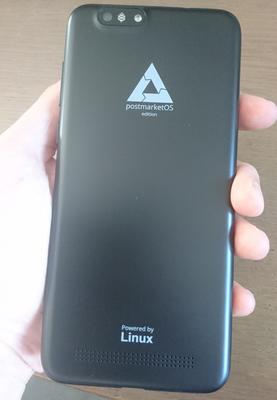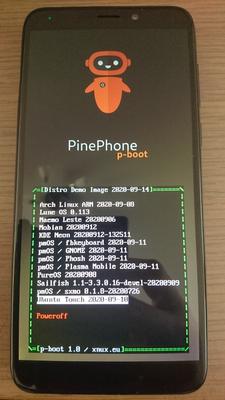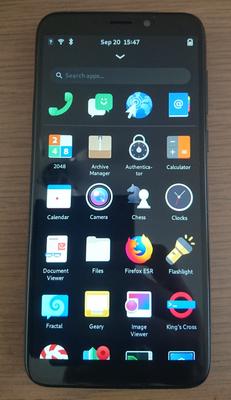Exploring the PinePhone with the multi-distro demo image
A few days ago my PinePhone arrived. It came with postmarketOS, which is based on Alpine Linux. By default it has a fairly limited set of apps. And if you look in the application manager, there are not many apps available to install either. With apk, Alpine's package manager, you can install a lot of other software. I installed Firefox this way, it seems to work, but you often need to zoom out to 50% to get the whole website on the screen.
But what I find most impressive is how this low-cost Linux phone has garnered extensive support from all major mobile Linux distributions. Who would have thought a few years ago that 'distro hopping' on a phone would be a thing?
Trying out some Linux distributions on the PinePhone
The easiest way to explore a lot of the supported distributions is the PinePhone multi-distro demo image, which is a 5 GB image with 13 distributions and a neat bootloader, p-boot.
So installed the multi-distro demo image on a spare microSD card with USBImager, resized the partition to the microSD card's full size and then I have been trying all 13 distributions for the last few days. These are my notes for the 2020-09-14 version of the image, not in any way systematic or complete: [1]
- Arch Linux
-
Boots into a command line. I don't even see a virtual keyboard appearing to log in. This is not what I expect from a phone, but it's very understandable coming from the Arch Linux philosophy :-)
- LuneOS
-
Has a bit more apps installed by default: maps, email, a PDF viewer, ... The maps app uses Google Maps data, but it doesn't work. I can't find general settings. It seems somewhat limited and basic things such as rebooting or shutting down don't work. LuneOS is based on webOS.
- Maemo Leste
-
Boots into landscape mode, and I can't find how to change it to portrait mode. It has Vim and Htop installed by default, but they crash. There's no browser installed by default. It has an app manager, but it doesn't have a lot of apps available to install. The settings are fairly limited. The virtual keyboard is barely usable. Maemo Leste is the successor of Nokia's Maemo and it's currently an ARM64 port of Devuan (Debian without systemd).
- Mobian
-
Has a good set of default apps. It has both Web and Firefox installed as web browsers. There's a To Do app, Processor usage, Telegram (the Desktop version), Maps (using OpenStreetMap), Geary for email. There's also an Authenticator app, but it doesn't show anything. There's no terminal installed by default. [2] Software shows a lot of apps, and you get access to a lot of GNOME settings, including accounts, for instance to set up your email account (Geary uses the accounts you have set up here). It definitely feels Linux-like, but at the same time feels like a real mobile operating system. It's essentially just Debian for ARM64 with the Phosh user interface developed by Purism for the Librem 5, and it works surprisingly well.
- KDE Neon
-
Looks nice, there are but not many apps installed. I'm more familiar with the GNOME world, so I feel a bit lost here. There's Spacebar (to chat), Koko (music), Okular (document viewer), Konsole. Contrary to all other distributions I tried, there's a screenshot app in the drawer. But how does it work? I don't think I will get used to the Plasma Mobile interface. So while it looks like a perfectly usable system, it's not for me.
- postmarketOS with fbkeyboard
-
Boots into a command line. The virtual keyboard needed to log in is quite usable, but this is not what I expect from a phone.
- postmarketOS with GNOME
-
I hear a high-pitched sound when the PinePhone boots into the graphical environment. The virtual keyboard has awkwardly small buttons. There's a terminal installed. But the apps are not easy to access: if you open the application drawer, the icons suddenly fly off the screen, so the only way to start the apps is by typing an app's name in the search box. There are a lot of GNOME settings. However, the system doesn't seem to be adapted to a mobile screen: windows are shown only partially, even the GNOME initial setup window. All in all, this is not very usable in this state.
- postmarketOS with Phosh
-
Also gives the high-pitched sound, but less long. There are not many apps preinstalled. There are also not many apps to install from Software. There are a lot of GNOME settings. Not all windows are adapted to the mobile screen size.
- postmarketOS with Plasma Mobile
-
I hear a high-pitched sound when the PinePhone boots into the graphical environment. A limited set of preinstalled apps. The system doesn't seem to be very responsive. I couldn't even enter my Wi-Fi settings because the interface hangs when I want to open the settings window. Unusable in this state.
- postmarketOS with sxmo
-
A nice lightweight alternative using suckless programs. Sxmo (Simple X Mobile) is actually a collection of simple programs and scripts to create a fully functional mobile user interface adhering to the Unix philosophy. It's a bit too minimalistic for me, but it works nicely to my surprise, controlling the user interface largely through the PinePhone's volume and power buttons and swipe gestures.
- PureOS
-
Has a limited set of apps. It seems to be better adapted to the mobile screen size than some of the other distributions. The default web browser is GNOME Web. There's no Firefox to install from the Software app. There seems to be an Iceweasel in the app, but it hasn't been updated since the version equivalent to Firefox 55! The available GNOME settings are rather limited.
- Sailfish OS
-
Looks very nice. It has a very user-friendly user onboarding experience. There's a fairly limited set of installed apps. The user interface is closed source, so this is no option for me.
- Ubuntu Touch
-
Looks very nice, it also a nice user onboarding experience. The default web browser is Morph. It also has a media player, weather app, music, terminal, navigation (uNav, but it didn't work for me, as it keeps "waiting for GPS"). It seems to be a bit slower to boot and less responsive than some of the other distributions. I also experienced some weird behaviour with the window placement.
Powered by Linux
The PinePhone supports even more Linux distributions: Fedora, Manjaro, Nemo Mobile (an open source build of Sailfish OS), NixOS, openSUSE and AVMultiPhone (basically postmarketOS with MATE). These are not (yet) available from the multi-distro demo image, and I haven't tried them yet.
As you see in my notes above, there are still a lot of issues if you want to use the PinePhone on a daily basis. [3] Most of them will probably be solved eventually: things seem to move very fast in this domain. Also, the fact that these are all just Linux distributions is extremely helpful. If you encounter a problem, you can have a look at dmesg, run systemctl list-units --state=failed and so on and you have the same powerful toolbox at your disposal as on the Linux desktop.
All in all, Mobian impressed me most, with PureOS as my second choice. So after distro hopping for the last few days, I'm going to do a clean install with Mobian and explore it further. The feeling of having freedom and control on my phone in a familiar environment is amazing. Powered by Linux!


